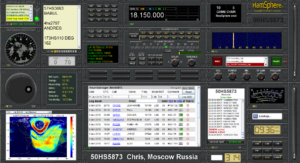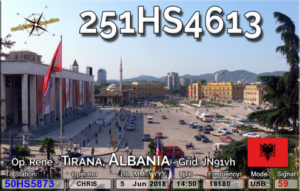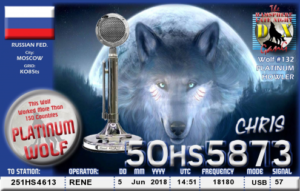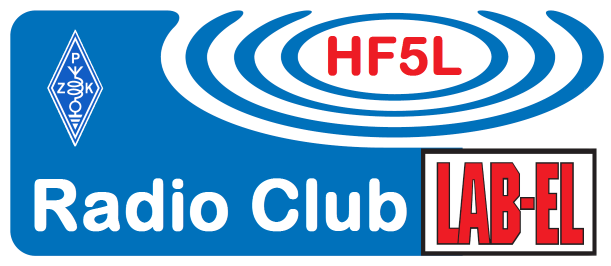The Hamsphere program is celebrating its 10th anniversary. Its originator and owner, Kelly (SM7NHC and 5B4IT), claims that it is not a typical “talk”, VOIP which are already several on the Internet, but a real radio program for hams, only in the Internet, with all the attributes of a real radio . We have there the same amateur HF and UHF bands and even 11m band – traditional for CB. By listening to the band, we hear the same “white noise” to further rein force the impression of reality. An example of the appearance of the basic version of the author’s virtual transceiver (one of hundreds of variants to choose from) is shown in the picture. WB7ECW has made several training videos showing the Hamsphere service in a professional way; You can find an example movie here. We run QSO, log station, send and receive QSL cards, participate in competitions, earn diplomas, etc. All this is automatically handled by the program, even the diplomas are automatically received after meeting the conditions. The entire program is of course run without paper; QSL cards or diplomas are, of course, computer graphics, you can view it on the screen or print it.
force the impression of reality. An example of the appearance of the basic version of the author’s virtual transceiver (one of hundreds of variants to choose from) is shown in the picture. WB7ECW has made several training videos showing the Hamsphere service in a professional way; You can find an example movie here. We run QSO, log station, send and receive QSL cards, participate in competitions, earn diplomas, etc. All this is automatically handled by the program, even the diplomas are automatically received after meeting the conditions. The entire program is of course run without paper; QSL cards or diplomas are, of course, computer graphics, you can view it on the screen or print it.
The first participants of Hamsphere in 2007 were friends of Kelly from CB Radio, later acquaintances of friends, therefore to this day, as a proof of memory and for sentimental reasons, the 11m band has been maintained. The code markings of countries (prefixes) have also been inherited from this band. The structure of the call sign in Hamsphere is the country’s prefix, then the HS letter and an individual digital suffix, for large countries generally 4-digit. I have been working from Moscow under the 50HS5873 callsign for several years. Holders of shortwave licenses can, of course, work under their own callsigns, provided they place them in the application and send a copy of the license to the administrators. The original platform, after a series of subsequent improvements, now known as Hamsphere 3, continues to enjoy great popularity, still larger than the parallel-developed Hamsphere 4 platform.
In 2014, a new version Hamsphere 4 appeared, a revolutionary concept that imitates the real radio to its maximum extent. This is not a platform consisting of many rooms, similar to Skype with additional features and radio attributes, which is basically HS3; the HS4 program simulates real propagation, taking into account not only the geographical location of the station, the time of day, but also the amount of sunspots! What’s more, the chances of hearing and establishing contatcs between stations also depend on the antennas used by the operators. Antenna characteristics are also simulated in detail, and there are many virtual antennas to choose from. By default, the operator receives one basic antenna for all bands, a vertical IDC with omnidirectional characteristic and one multiband rotating Fishbone Array with the rotor. OmniDX single antenna antennas are very good, they “hear” everything, “see” 180 degrees, or V-collinear – vertical but several times stronger than IDC – cost 13 Euro per piece, but there are also amateurs buying more expensive – but multi-band antennas. The single-band Yagi Stack 4×2 antennas are considered the strongest.
Until today, both programs operate in parallel, as part of one annually renewed membership fee, everyone has the right to use both. Each program has its own separate operating principle and a separate database including logs, the principle of counting points, its set of diplomas, its own QSL card base, etc. And although the developers of the program are doing everything to make the HS4 develop faster, it is not entirely successful. According to the idea of the creators, HS3 is meant to increase the operator’s level of users, so that they can reach the next level, which is undoubtedly the HS4.
In 2017, the Hamsphere 4 service program was created for the Android platform – the “mobile” world is unleashed, with separate devices, antennas, achievement diplomas, etc. It operates under a common base with HS4 and complements it. The program is constantly evolving; at first there were only phone contacs, then telegraphy joined, this year for the first time we have two CW contests a year, in the calendar there were competitions in PSK31, RTTY, SSTV emissions and group RDF competitions.

There is a group of purists that Hamsphere will never please, because it is just an illusion. A familiar operator, active both in Hamsphere and in the normal 4Z5DW radio ham, told how, proud of his “built-in” hands of the HS4 multi-module transceiver, showed his performance and made several demonstration contacts, he met with an interesting reaction. Colleagues, the operators praised the program, but they firmly stated that they would not work in it because it reminds them of contact with latex women.
However, you must take into account the wisdom contained in the meme “If you get kids interested in amateur radio, they will never have money for alcohol and drugs” (John Mittnik – FB Amateur Radio Funnies). It indicates that amateur radio is a fairly expensive hobby. It requires both more money and skills, as well as meeting additional conditions, not always dependent on us and possible to meet. Hamsphere in the base version only requires payment of an annual fee of 30 Euro and a computer (tablet, smartphone) with Internet access.
There is a large group of Hamsphere users, usually older, whose professional life was associated with the radio, but they do not have an amateur license or a special desire to apply for it, take exams, etc. Another group were amateur radio players who had several, sometimes several dozen years break and “for old years” (which is often associated with retirement), they return to the hobby with a non-renewed license. A large group is also simply older people who have a lot of time and are curious about communication with the world. There is also a group of young people who, through Hamsphere, takes courage and experience to apply for a license or a higher category of permit.
Another differentiating element is the issue of antennas. In the real world it is increasingly difficult to install an antenna in the city, not only because of the possibility of causing interference, but also because of the lack of approval of the administration of buildings. Even happy owners of houses outside the city are not always free from troubles; only some of them have the possibility to install the antennas by themselves, a significant part has only operator abilities. And finally, more complex constructions are expensive and take up a lot of space. Not everyone can afford the forest of antennas outside the window. In Hamsphere, the problem does not exist, in HS4 each subscriber receives a nice rotating antenna with a rotor for free, and the store has a choice of dozens of ready-made structures with different characteristics. Although it’s just fiction or virtual reality, I assure you it’s a great feeling to rotate the Yagi Stack system and hear how Canada or Colombia emerges from the noise. I will just add that some of the systems, especially for the 80 or 160m bands, would have real dimensions of the football field. KA4PNV has published an interesting presentation, where it compares the real “ham radio” and online simulations: Hamsphere 4, CQ100, Hamsphere 3, the most space devoting HS4.
Hamsphere administration in its jubilee bulletin reports that the system has tens of thousands of users. I believe that the number of active users is rather a few thousand, with a 40:60 proportion to the detriment of HS4. This is not much, but communication can be done. QRM is a bit smaller, but there are also pile-ups and some dx-expeditions have to work with the use of split (the virtual transceivers give this possibility). The largest number of operators comes from North America and Europe. There are a lot of native English-speaking operators, apart from the United Kingdom and the Republic of Ireland, we have US operators and many ex-pats (specialists working outside their home country). Hamsphere is very popular also in the Benelux countries, there are far fewer users in German-speaking countries.

The lack of “full cast” of the operator in many countries included in the DXCC is easily compensated by numerous dx-expeditions. In Hamsphere, the expedition does not require any logistical effort, arranging approvals and permits, equipment and antennas. You need a notebook, access to the Internet and agreeing with the administration of the HS. “Expedition” is not always the main goal, sometimes it makes the time of leave more enjoyable, sometimes it diversifies the business trip. The various HS clubs also organize activity days, specific competitions with prizes, in which selected stations send QSL cards, and the operators may additionally obtain a diploma or a prize.
Because there are relatively few users, there are many more repeated contacts in Hamsphere than in real radio. This promotes making friends, going beyond the standard; even if your language skills are poor, you can still add friends to Facebook and translate Google. Hamsphere has its official web-site, divided for users of both platforms, but everyday life has gone to Facebook. It’s hard to say that we all know each other well and we like it, the language barrier does not allow it, often also temperament differences, but Hamsphere is a place where it is worth being.
There are not many Poles on the HS, probably about a dozen on HS4 and twice as much on HS3. However, it is still much more than in any country bordering on us (except Russia). But it is not the quantity that matters, but the quality; Poles are known and respected in the HS. Marcin from Warsaw, 161HS363 was already DX Manager HS, who, although he is no longer in the HS, is still in the top ten HS3 ranking (Top2000), he is 9th with 208 confirmed countries. In the more prestigious HS4 ranking (Top1000) Wojtek SP4QCU occupies the third position in the world – 177 confirmed countries, over 29 thousand. QSO, 6xDXCC (on 6 different bands), and Andrzej SP2DNI either won or placed in the forefront of all CW contests.
Krzysztof SP5GNG, 50HS5873

Number of Comments: 2
I have the Hamsphere on the computer screen.
I see the needle moving slightly from left to right.
BUT I DO NOT SEE ANY SIGNALS ON THE SCOPE.
I I have asked hamsphere why I do not, and they told that I am in the Split mode.
How do I change the mode?
Dear friend, from yout description I can not even tell what system you are reffering to: HS3 or HS4 do not understand the problem, If you asked Hamsphere and they answered, please ask them again to clarify. http://www.hamsphere.com/support
73 de 50HS5873